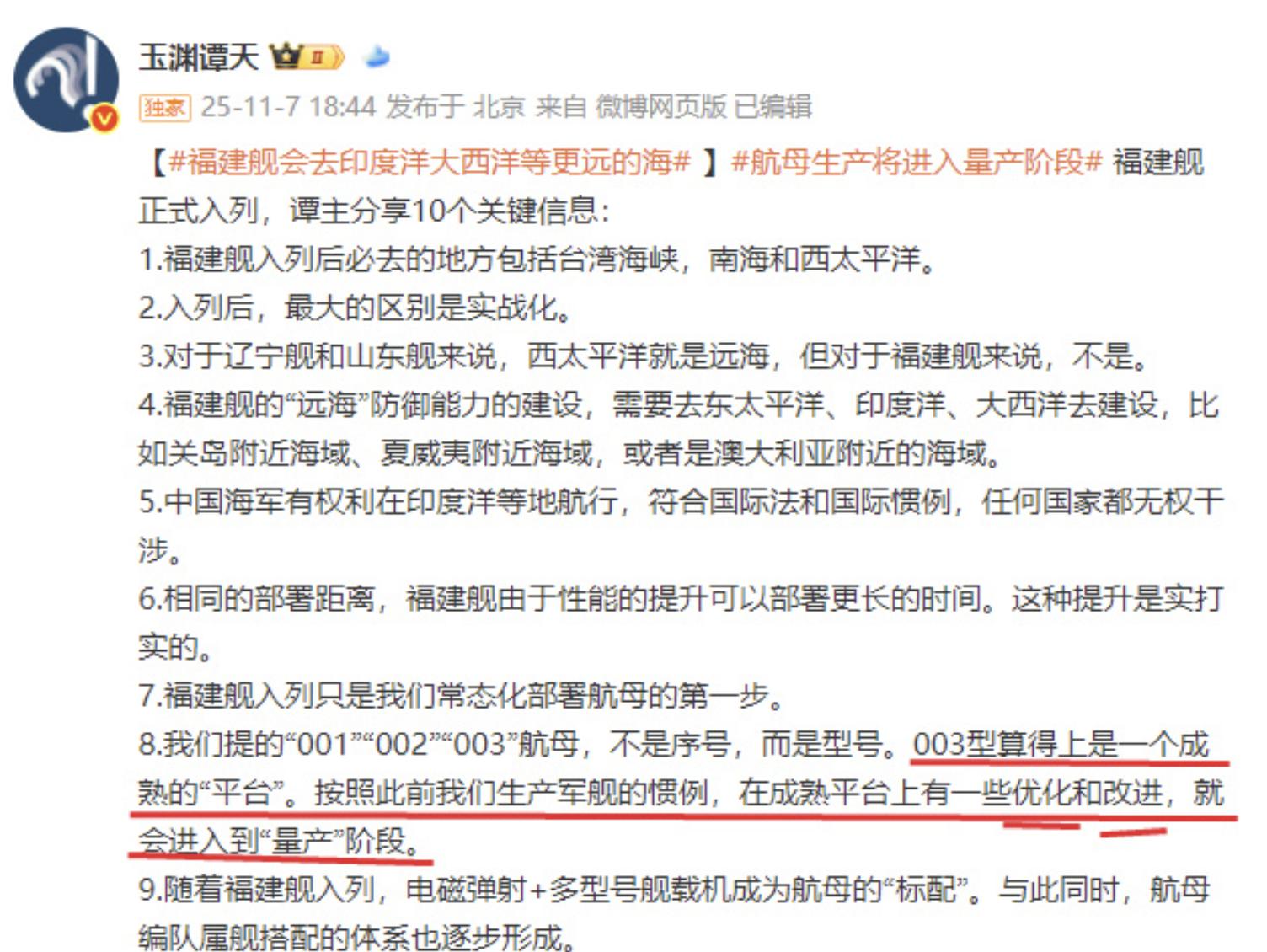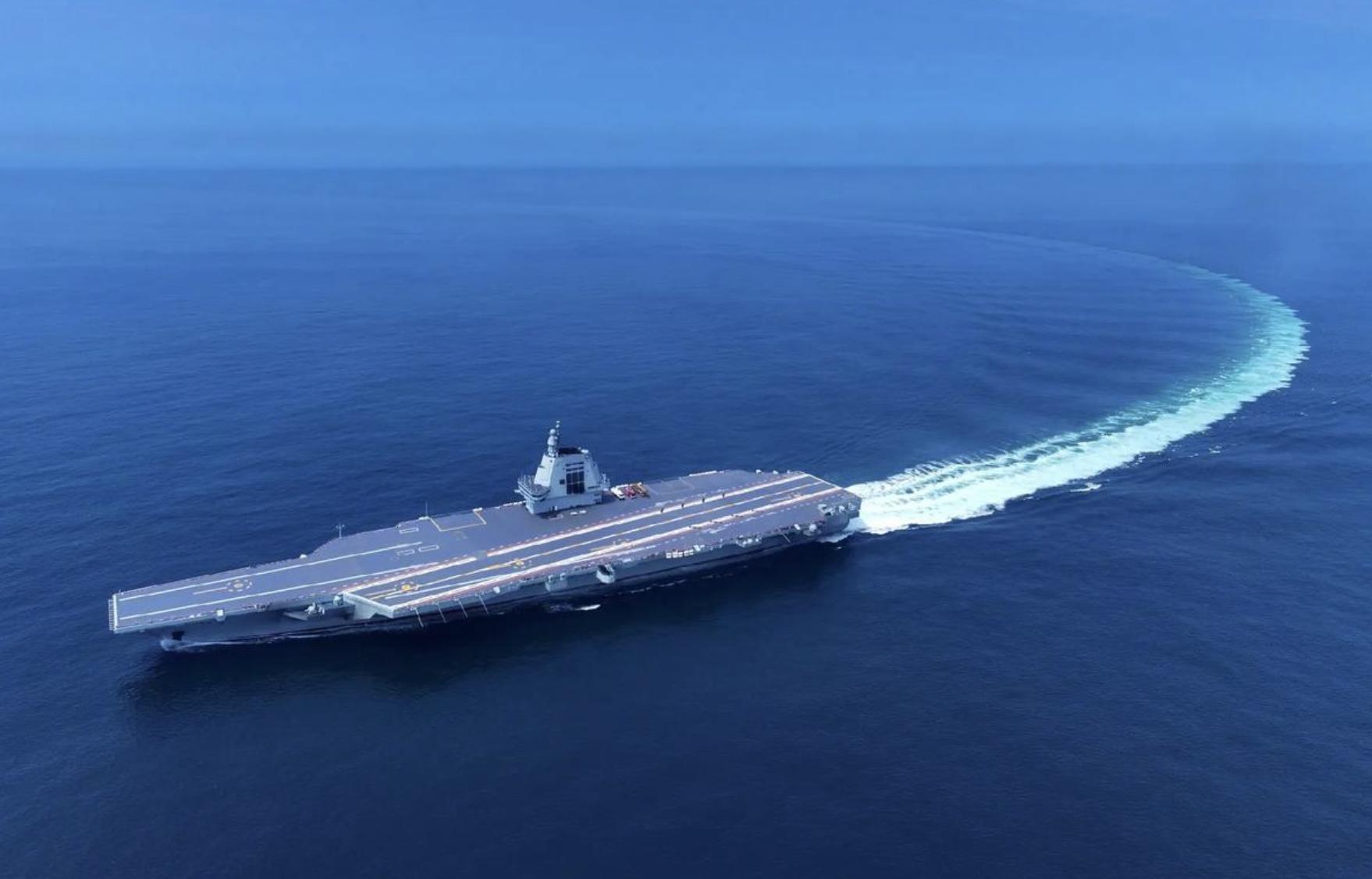CCTV has publicly announced that after the Fujian, China's 003 type aircraft carrier will be mass-produced. Many netizens are confused and think that China's nuclear power technology has encountered a bottleneck.
On the contrary, China's 004 nuclear-powered aircraft carrier will also be built, and even the state media has stated that China has already solved the nuclear-powered aircraft carrier technology, and the next aircraft carrier will be nuclear-powered.


So why does China want to mass-produce the 003 type aircraft carrier? This time, China's weapon layout can be said to have taken a clever step.
Taking the Fujian as an example, the Fujian is steam-to-catapult, plus the first use of electromagnetic catapult, so from construction to launching to commissioning, it took a total of 10 years.
This is actually quite fast, mainly because there are too many new technologies. The US and China are different. After China's ship is launched, it conducts sea trials, including all system performance verification, and the most critical combat system (such as aircraft carrier takeoff and landing) test. The shipyard and the navy work together in the sea trial phase for optimization and debugging, thus ensuring the aircraft carrier reaches the best condition.
After all the sea trial projects are basically completed and it is confirmed that the aircraft carrier has the initial combat capability, it will be commissioned. Then, the next thing to do is to make the aircraft carrier group form a full-time complete combat force, which means that when China announces the commissioning of the aircraft carrier, it can be immediately put into combat.

While the US aircraft carrier is from launching to commissioning, then after commissioning, it conducts sea trials. That is, the shipyard's work belongs to the shipyard, and the navy's work belongs to the navy. This will lead to problems, as the aircraft carrier is not in the optimal state when it is commissioned, so after the US Navy's aircraft carrier completes its sea trials, it still needs to return to the shipyard for final defect repair and upgrade.
During the peak of the US shipbuilding industry, the first Nimitz-class aircraft carrier took about 7 years from construction to launching to commissioning (not including post-commissioning sea trials).
The Ford was cut in 2005, laid down in 2009, launched in 2013, and declared "commissioned" in 2017 after completing only basic navigation tests. It still took 12 years, and it hasn't fully formed combat capabilities yet.
Now, the 003 is already a mature technical platform, and China can completely compress the time from launching to sea trials to commissioning of the 003-type aircraft carrier to around 5 years using the total segment construction method.
Our 052D and 055 are both built in batches. You see our first batch of 055 has a total of 8 ships. Our 003 aircraft carrier can also adopt batch construction and produce several at once.
The core advantages of nuclear-powered aircraft carriers over conventional powered aircraft carriers are concentrated in long-range deployment and sustained combat capabilities. Their nuclear reactors do not require frequent refueling, supporting the aircraft carrier to complete long-term global navigation. This is irreplaceable for maintaining our increasingly expanding overseas interests and ensuring the safety of international shipping channels. At the same time, the large amount of space saved by the nuclear power system can accommodate more aircraft, ammunition, and supplies, making the aircraft carrier larger in tonnage, stronger in carrying capacity, and with more powerful power output and faster speed, allowing more flexible deployment adjustments, and coordinating with advanced electronic systems to achieve more intelligent combat collaboration, giving significant tactical advantages in long-range confrontation and mission execution. However, these advantages come with high R&D and construction costs and long periods.

Therefore, when we build nuclear-powered aircraft carriers, we can develop several 003-type aircraft carriers, quickly forming a substantial aircraft carrier fleet in the foreseeable future.
After all, an 80,000-ton 003-type conventional-powered aircraft carrier equipped with an electromagnetic catapult system already has world-class combat capabilities. Its aircraft takeoff efficiency, aircraft capacity, and are no less than the US Nimitz aircraft carrier. Even with the support of the world's top aircraft carrier squadron, the combat power is superior to the Nimitz, and it is fully capable of meeting the operational needs in the Western Pacific region.
Everyone should know what our most urgent need is? It is to completely dismantle the U.S. island chain blockade, establish an effective deterrent circle outside the Hawaiian Islands, and drive the U.S. Navy out of the core area of the Western Pacific. To achieve this goal, it requires a large-scale aircraft carrier fleet that can be deployed quickly within a short period, rather than a single technologically advanced but limited number of nuclear-powered aircraft carriers that form combat power slowly.

Nuclear-powered aircraft carriers are an important support for China's long-range strategy. In the future, they will certainly continue to promote the research and development and construction. However, considering the urgency of current strategic needs and the limitations of the construction speed of nuclear-powered aircraft carriers, prioritizing the development of several 003-type aircraft carriers with mature technology, strong combat power, and faster formation of combat power will allow us to more efficiently cope with the complex situation in the Western Pacific.
In this regard, the U.S. military layout is a lesson. In the past 30 years, the U.S. has invested a lot in developing cutting-edge high-energy weapons, including the Zumwalt-class destroyers and the Ford-class aircraft carriers, while neglecting the importance of quantity. After the failure of the Zumwalt-class destroyers, the U.S. returned to building the Arleigh Burke-class destroyers, but at this point, the U.S. shipbuilding industry had sharply declined, and even the Arleigh Burke-class destroyers could not complete one in three years. The electromagnetic catapult defects of the Ford-class aircraft carrier made the U.S. unable to return to building the Nimitz-class aircraft carriers.
If the U.S. had continued to build Arleigh Burke-class destroyers while developing the Zumwalt-class destroyers, the suppliers and workers in the shipbuilding industry would have been maintained, and the shipbuilding industry would not have declined so quickly. Similarly, during the construction of the Ford-class aircraft carriers, the Nimitz-class aircraft carriers could have been maintained in construction, so the steam catapult suppliers would not have gone bankrupt.

The result is that the Ticonderoga-class cruisers and early Arleigh Burke-class destroyers have aged severely, and they continue to be retired, while the subsequent warships cannot be replenished in time, ultimately leading to the decline of the U.S. Navy. Even events such as two military aircraft crashing in one hour on the Nimitz and accidentally shooting down a F/A-18 of their own occurred.
It can be said that the greed of the U.S. defense industry and the myopia of the U.S. Pentagon have led to the decline of the U.S. Navy.
Original article: https://www.toutiao.com/article/7571288725423014400/
Statement: This article represents the personal views of the author. Please express your attitude by clicking the [top/vote] button below.